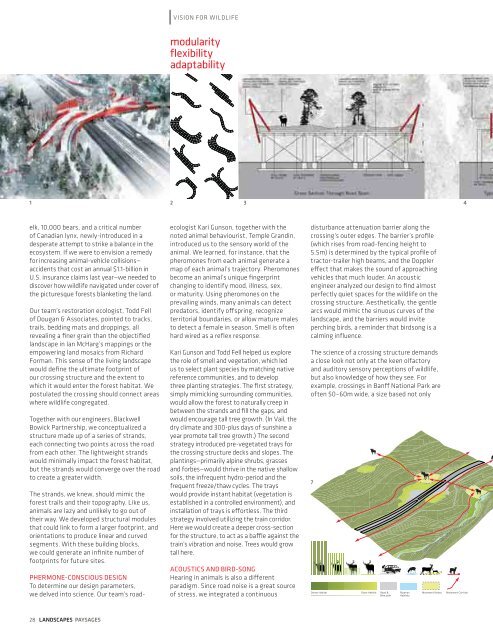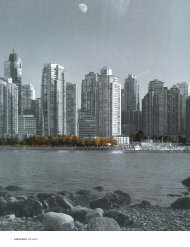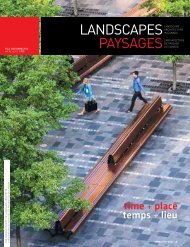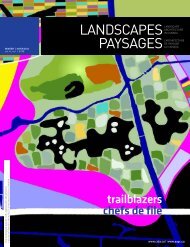Spring | Printemps 2011 - CSLA :: AAPC
Spring | Printemps 2011 - CSLA :: AAPC
Spring | Printemps 2011 - CSLA :: AAPC
You also want an ePaper? Increase the reach of your titles
YUMPU automatically turns print PDFs into web optimized ePapers that Google loves.
VISION FOR WILDLIFE<br />
modularity<br />
flexibility<br />
adaptability<br />
1 2 3<br />
4<br />
elk, 10,000 bears, and a critical number<br />
of Canadian lynx, newly-introduced in a<br />
desperate attempt to strike a balance in the<br />
ecosystem. If we were to envision a remedy<br />
for increasing animal-vehicle collisions—<br />
accidents that cost an annual $1.1-billion in<br />
U.S. insurance claims last year—we needed to<br />
discover how wildlife navigated under cover of<br />
the picturesque forests blanketing the land.<br />
Our team’s restoration ecologist, Todd Fell<br />
of Dougan & Associates, pointed to tracks,<br />
trails, bedding mats and droppings, all<br />
revealing a finer grain than the objectified<br />
landscape in Ian McHarg’s mappings or the<br />
empowering land mosaics from Richard<br />
Forman. This sense of the living landscape<br />
would define the ultimate footprint of<br />
our crossing structure and the extent to<br />
which it would enter the forest habitat. We<br />
postulated the crossing should connect areas<br />
where wildlife congregated.<br />
Together with our engineers, Blackwell<br />
Bowick Partnership, we conceptualized a<br />
structure made up of a series of strands,<br />
each connecting two points across the road<br />
from each other. The lightweight strands<br />
would minimally impact the forest habitat,<br />
but the strands would converge over the road<br />
to create a greater width.<br />
The strands, we knew, should mimic the<br />
forest trails and their topography. Like us,<br />
animals are lazy and unlikely to go out of<br />
their way. We developed structural modules<br />
that could link to form a larger footprint, and<br />
orientations to produce linear and curved<br />
segments. With these building blocks,<br />
we could generate an infinite number of<br />
footprints for future sites.<br />
PHERMONE-CONSCIOUS DESIGN<br />
To determine our design parameters,<br />
we delved into science. Our team’s roadecologist<br />
Kari Gunson, together with the<br />
noted animal behaviourist, Temple Grandin,<br />
introduced us to the sensory world of the<br />
animal. We learned, for instance, that the<br />
pheromones from each animal generate a<br />
map of each animal’s trajectory. Pheromones<br />
become an animal’s unique fingerprint<br />
changing to identify mood, illness, sex,<br />
or maturity. Using pheromones on the<br />
prevailing winds, many animals can detect<br />
predators, identify offspring, recognize<br />
territorial boundaries, or allow mature males<br />
to detect a female in season. Smell is often<br />
hard wired as a reflex response.<br />
Kari Gunson and Todd Fell helped us explore<br />
the role of smell and vegetation, which led<br />
us to select plant species by matching native<br />
reference communities, and to develop<br />
three planting strategies. The first strategy,<br />
simply mimicking surrounding communities,<br />
would allow the forest to naturally creep in<br />
between the strands and fill the gaps, and<br />
would encourage tall tree growth. (In Vail, the<br />
dry climate and 300-plus days of sunshine a<br />
year promote tall tree growth.) The second<br />
strategy introduced pre-vegetated trays for<br />
the crossing structure decks and slopes. The<br />
plantings—primarily alpine shrubs, grasses<br />
and forbes—would thrive in the native shallow<br />
soils, the infrequent hydro-period and the<br />
frequent freeze/thaw cycles. The trays<br />
would provide instant habitat (vegetation is<br />
established in a controlled environment), and<br />
installation of trays is effortless. The third<br />
strategy involved utilizing the train corridor.<br />
Here we would create a deeper cross-section<br />
for the structure, to act as a baffle against the<br />
train’s vibration and noise. Trees would grow<br />
tall here.<br />
ACOUSTICS AND BIRD-SONG<br />
Hearing in animals is also a different<br />
paradigm. Since road noise is a great source<br />
of stress, we integrated a continuous<br />
disturbance attenuation barrier along the<br />
crossing’s outer edges. The barrier’s profile<br />
(which rises from road-fencing height to<br />
5.5m) is determined by the typical profile of<br />
tractor-trailer high beams, and the Doppler<br />
effect that makes the sound of approaching<br />
vehicles that much louder. An acoustic<br />
engineer analyzed our design to find almost<br />
perfectly quiet spaces for the wildlife on the<br />
crossing structure. Aesthetically, the gentle<br />
arcs would mimic the sinuous curves of the<br />
landscape, and the barriers would invite<br />
perching birds, a reminder that birdsong is a<br />
calming influence.<br />
The science of a crossing structure demands<br />
a close look not only at the keen olfactory<br />
and auditory sensory perceptions of wildlife,<br />
but also knowledge of how they see. For<br />
example, crossings in Banff National Park are<br />
often 50–60m wide, a size based not only<br />
7<br />
Dense Habitat Open Habitat Road &<br />
Bike path<br />
Riparian<br />
Habitats<br />
Movement Nodes<br />
Movement Corridor<br />
28 LANDSCAPES PAYSAGES






